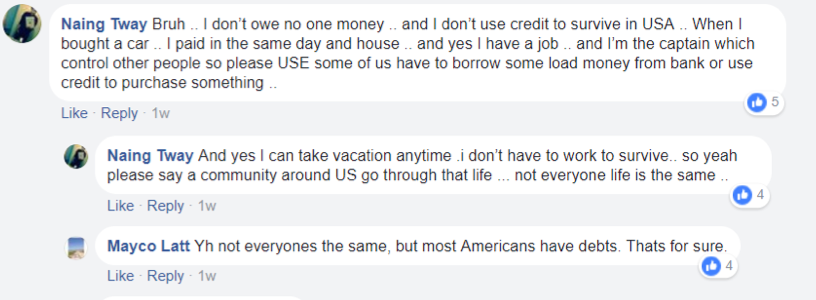A Facebook video attempting to dispel common misconceptions about Burmese-Americans has recently gone viral and sparked debate within and between Myanmar communities across the world.
The co-hosts of the video, Chan Chan and Chan Aung, are two young Burmese-Americans living in Washington, DC, who make Myanmar language videos on a wide range of topics on a Facebook page called Tea Time. Their video on Burmese-Americans is the most watched video produced by Tea Time so far and has been viewed over 344,000 times. In this video, they address five misconceptions they feel people in Myanmar have of their counterparts in the US.
Misconception 1: The US is paradise
According to the duo, “[Myanmar people in Myanmar] think we live in a paradise” and assume that those who live abroad automatically have an easy life with lots of money. Chan Aung says that, in actuality, Burmese-Americans are poor, came to the US with the help of loans, and have to use loans and credit cards in order to pay for their basic expenses.
Misconception 2: Living in the US is easy
Being in the US is “a lot of work.” Chan Chan shared her experience of making sushi rolls until her arms were sore, and Chan Aung describes having to get up early to take the bus to get to work. They claim that they have to work far harder than people do in Myanmar and that people don’t know what hard work was until they come to the US.
Misconception 3: Burmese-Americans are rich
Chan Aung tell viewers: “You don’t become rich just because you arrive in a foreign country.”
However, he admits that while Burmese-Americans live with little disposable income, the standard of life is much higher in the US and that, in a way, it needs to be. The weather can be cold, and everything is very far apart, so a car becomes a necessity. Chan Chan reminds the audience that Burmese-Americans are not rolling in money, and that these cars are bought with loans that require monthly payments that, in turn, requires them to work hard every day.
Misconception 4: Living in the US is like being in a movie
The pair also reassures viewers that life for Burmese-Americans does not resemble any Hollywood movies. Their lives are “fast-paced” and don’t typically involve smoking cigarettes, using drugs, going to parties, or sleeping around. Young Burmese-Americans “go to school, go home, then sleep,” they say. Movies might make the US look fun and wild, but that’s not how most Burmese-Americans experience it.
Misconception 5: Burmese Americans all know each other
The US is a large country, and it can take an entire week to drive from coast to coast, the hosts point out. Chan Chan uses her arms very expressively to demonstrate how spread out Burmese-Americans can be living from one another, and Chan Aung says that just because they all live in one country doesn’t mean Burmese-Americans all know each other.
Dispelling Stereotypes
The duo end the video by asking viewers to comment on how they see Myanmar people who live abroad, and the Myanmar netizens were more than happy to comply.
Many viewers were happy to see a video that talked about poverty and those who work so hard in what is seen as the land of opportunity and still cannot make ends meet.

Others spoke about how these stereotypes effect their interactions with their families.

Burmese-Americans Have a Diversity of Experiences
One commenter pointed out that a Burmese-American’s experience depends on their immigration status and that using credit is part of the American way of life and not necessarily an indicator that someone is poor.

Others took offense that a video that intended to disprove stereotypes ended up creating different ones.

Make Better Life Choices
To some, having to work hard in the US is the simple result of poor decision making. They advise Chan Chan to choose a non-sushi related career path and to manage her money better if she want an easier life.



Apples and Oranges
Many commenters acknowledged that those in the US also have to work hard but take issue with the hosts comparing the hardships of those in the US and those in Myanmar.


Others pointed out the difference in the metrics to measure financial success and middle class success in Myanmar and abroad.







